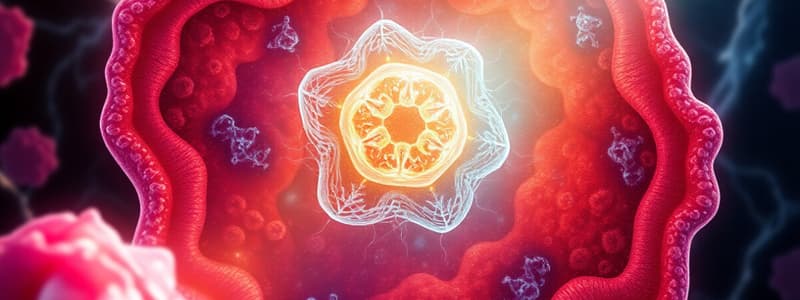Podcast
Questions and Answers
What is the primary function of root hair cells?
What is the primary function of root hair cells?
- To conduct water and minerals.
- To absorb water and minerals. (correct)
- To store carbohydrates.
- To provide support.
Which characteristic allows xylem cells to efficiently transport water?
Which characteristic allows xylem cells to efficiently transport water?
- A large vacuole.
- High concentration of cytoplasm.
- Presence of cross walls.
- Lignified walls. (correct)
What adaptation allows muscle cells to perform their function effectively?
What adaptation allows muscle cells to perform their function effectively?
- Ability to conduct electricity.
- Presence of strong cell walls.
- Very low number of mitochondria.
- Storage of carbohydrates in the form of glycogen. (correct)
How does the structure of xylem contribute to its function?
How does the structure of xylem contribute to its function?
Which of the following describes a main characteristic of invertebrates mentioned?
Which of the following describes a main characteristic of invertebrates mentioned?
What is the role of mitochondria in muscle cells?
What is the role of mitochondria in muscle cells?
Which of the following does NOT describe a modified cell?
Which of the following does NOT describe a modified cell?
What is the significance of pits in the structure of xylem cells?
What is the significance of pits in the structure of xylem cells?
Which of the following best defines modification in cells?
Which of the following best defines modification in cells?
What is magnification in the context of imaging?
What is magnification in the context of imaging?
What is one of the main characteristics of insects?
What is one of the main characteristics of insects?
Which class of arthropods includes species with compound eyes?
Which class of arthropods includes species with compound eyes?
How do insects primarily adapt to hide from enemies?
How do insects primarily adapt to hide from enemies?
What is a characteristic feature of arthropods regarding their body structure?
What is a characteristic feature of arthropods regarding their body structure?
How many pairs of jointed legs do insects have?
How many pairs of jointed legs do insects have?
What is the primary material composing the exoskeleton of arthropods?
What is the primary material composing the exoskeleton of arthropods?
Which of the following is NOT an adaptation of insects?
Which of the following is NOT an adaptation of insects?
What unique feature do arachnids possess that differentiates them from insects?
What unique feature do arachnids possess that differentiates them from insects?
Which class of arthropods is characterized by having a wide range of leg pairs, varying from one to multiple pairs?
Which class of arthropods is characterized by having a wide range of leg pairs, varying from one to multiple pairs?
What role do antennae play in insects?
What role do antennae play in insects?
Flashcards are hidden until you start studying
Study Notes
Cell Structure and Function
- Cells are the basic structural and functional units of all living organisms.
- Examples include palisade cells and kidney cells.
Tissue
- Tissues consist of groups of similar cells performing specific functions.
- Examples are xylem and phloem in plants.
Organ
- Organs are composed of multiple tissues working together for particular functions.
- Examples include leaves, roots, liver, and heart.
Organ System
- Organ systems consist of groups of organs that perform closely related functions.
- Examples include the circulatory and respiratory systems in animals, and the shoot and root systems in plants.
Modification
- Cell modification refers to changes in shape or structure for specific functions.
Modified Cells
-
Root Hair Cells
- Adapted for water and mineral absorption.
- Features include finger-like projections for increased surface area, high mitochondrial content for energy, and large vacuoles for osmosis.
-
Xylem Cells
- Specialized for conduction of water and minerals.
- Adaptations include fine tubes for capillary action, lignified walls for support, pits for fluid distribution, and absence of cross walls and cytoplasm to facilitate fluid movement.
-
Muscle Cells
- Modified for contraction and movement.
- Characteristics include high numbers of mitochondria, ability to respire anaerobically for energy, glycogen storage for energy, and contractile filaments in the cytoplasm.
-
Other Modified Cells
- Examples include ciliated epithelium, sperm cells, and red blood cells.
Magnification
- Magnification indicates how much larger an image appears compared to the actual object.
- Use a triangle method to calculate magnification or actual length.
Characteristics of Invertebrates
- Many invertebrates have segmented bodies with flexible joints for movement.
- Possess exoskeletons made of chitin for protection and support.
- Typically have pairs of jointed legs for enhanced mobility.
- Segments are often grouped into distinct regions such as head, thorax, and abdomen.
Main Classes of Arthropods
- Key classes include insects, arachnids, crustaceans, and myriapods.
Class Insects
- Body structure divided into head, thorax, and abdomen.
- Three pairs of jointed legs and one pair of antennae.
- Possess compound eyes, with some species having simple eyes.
Adaptations of Insects
- Compound eyes enable wide vision.
- Antennae are used for sensory reception.
- Small size aids in evading predators.
- Jointed legs allow for quick movement.
- Segmented bodies facilitate movement.
- Exoskeleton provides protection and support.
Studying That Suits You
Use AI to generate personalized quizzes and flashcards to suit your learning preferences.



